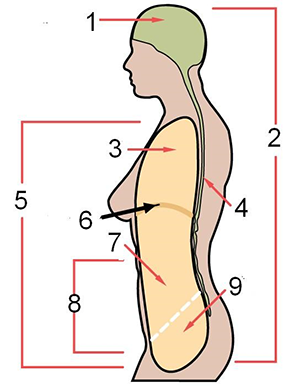Anatomy and Physiology
Ch 1 Review Guide - Introduction to Anatomy and Physiology
1. What is anatomy and physiology (definitions)?
2. Why does the body need to maintain homeostasis?
3. What are the levels of organization, from simplest to most complex?
4. Describe the functions of human life (organization, metabolism, etc).
5. Why do cells differentiate during development?
6. What is the relationship between metabolism and energy?
7. What are the requirements for human life?
8. What happened to Kati (the runner) and how was her condition diagnosed? What are vital signs?
9. What is a negative feedback loop? Give an example.
What is a set point?
What are effectors?
Explain the glucagon - insulin feedback loop.
10. What is a positive feedback loop? Give an example.
11. Describe the body cavities, what organs are found in each and be able to identify them on a diagram.

12. Identify body regions by description and by image ( examples: cervical, orbital, pedal, etc)

13. Know anatomical terminology. (prone, supine, medial, lateral, proximal, distal, dorsal, ventral, anterior, posterior, superficial, deep)
14. Describe the membranes and their locations (parietal vs visceral)
15. Describe the organ systems, their functions, and organs found in each (See concept map)
16. Label body sections on a diagram (sagittal, transverse, coronal)
Study Tips
1. Spend at least one hour reviewing your notes, pay special attention to terms and images you labeled
2. Review your handouts, practice naming (labeling) without looking at the answers
3. Practice the quizzes posted on Google Classroom. You should be able to get a 100% with practice!
4. Make flashcards or use Quizlet to practice (quizlet has a flashcard option).
5. ALL handouts, notes and presentations are available on Google Classroom.
Quizlets:
